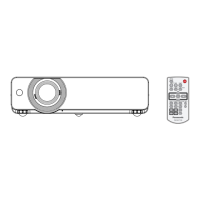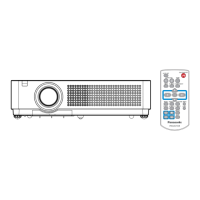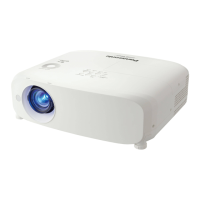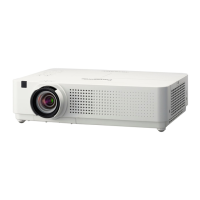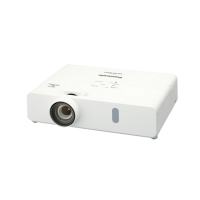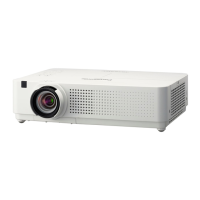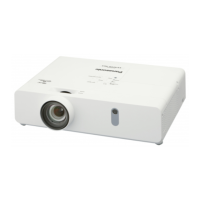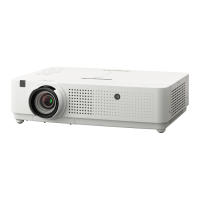Do you have a question about the Panasonic PT-VX500 and is the answer not in the manual?
Details on power supply, consumption, LCD panel size, display method, pixels, and configuration.
Specifications for the projector lens, including throw ratio, lamp, screen size, colors, brightness, and contrast.
Information on native resolution, supported scanning frequencies for various signal types, and dot clock limits.
Details on optical axis shift, keystone correction, installation options, built-in speaker, and terminal overview.
Details on projector dimensions, weight, operation noise, and environmental operating conditions.
Information on the remote control unit, supplied accessories, and optional accessories.
Illustrative diagram showing the physical dimensions of the projector.
Diagram identifying and numbering all projector input and output terminals.
Diagram illustrating the standard projector mounting and image projection position.
Table detailing projection distance and height based on screen size for a 4:3 aspect ratio.
Formulas to calculate projection distance for screen sizes not listed in the table.
Illustrations showing the shift range of the projected image for floor and ceiling mounts.
Information on the permissible vertical and horizontal installation angles for the projector.
Table listing supported display modes, resolutions, scanning frequencies, dot clock, and formats.
Details on compatibility for WXGA, SXGA, UXGA, and WUXGA resolutions and their parameters.
Information on the RS-232C serial connector, pin assignments, and signal names.
Factory settings for communication, basic command format, and format with sub-commands.
Pin assignment details for projector and PC (DTE) cables used for control.
List of commands for power control, volume, input selection, and picture mode settings.
Commands to request projector status like power, lamp, input signal, volume, and picture mode.
Definitions for command parameters and an example of sending a volume control command.
Guidelines for safe placement, ensuring adequate space for ventilation and operation.
Diagram illustrating the air intake and exhaust flow for proper projector cooling.
Notes on operating the projector continuously, including impact on lamp life.
Details on power supply, consumption, LCD panel size, display method, pixels, and configuration.
Specifications for the projector lens, including throw ratio, lamp, screen size, colors, brightness, and contrast.
Information on native resolution, supported scanning frequencies for various signal types, and dot clock limits.
Details on optical axis shift, keystone correction, installation options, built-in speaker, and terminal overview.
Details on projector dimensions, weight, operation noise, and environmental operating conditions.
Information on the remote control unit, supplied accessories, and optional accessories.
Illustrative diagram showing the physical dimensions of the projector.
Diagram identifying and numbering all projector input and output terminals.
Diagram illustrating the standard projector mounting and image projection position.
Table detailing projection distance and height based on screen size for a 4:3 aspect ratio.
Formulas to calculate projection distance for screen sizes not listed in the table.
Illustrations showing the shift range of the projected image for floor and ceiling mounts.
Information on the permissible vertical and horizontal installation angles for the projector.
Table listing supported display modes, resolutions, scanning frequencies, dot clock, and formats.
Details on compatibility for WXGA, SXGA, UXGA, and WUXGA resolutions and their parameters.
Information on the RS-232C serial connector, pin assignments, and signal names.
Factory settings for communication, basic command format, and format with sub-commands.
Pin assignment details for projector and PC (DTE) cables used for control.
List of commands for power control, volume, input selection, and picture mode settings.
Commands to request projector status like power, lamp, input signal, volume, and picture mode.
Definitions for command parameters and an example of sending a volume control command.
Guidelines for safe placement, ensuring adequate space for ventilation and operation.
Diagram illustrating the air intake and exhaust flow for proper projector cooling.
Notes on operating the projector continuously, including impact on lamp life.
| Display Technology | LCD |
|---|---|
| Brightness | 5000 ANSI Lumens |
| Native Resolution | XGA (1024 x 768) |
| Aspect Ratio | 4:3 |
| Contrast Ratio | 2000:1 |
| Projection Size | 30 - 300 inches |
| Input Terminals | HDMI, VGA, S-Video, Composite Video |
| Output Terminals | VGA |
| Noise Level | 29 dB (Eco mode) |
